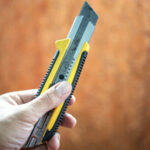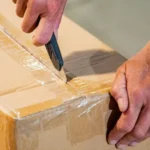Cutting cardboard with a box cutter is one of the most common tasks in a warehouse, but it can also be unsafe. This blog post will discuss 14 simple safety tips to help you work safely and efficiently with your box cutters.
This includes general principles for safe use and specific tips for cutting corners and scoring points on boxes. If you follow these safety tips closely, you won’t have problems working with your box cutter.
Tip 1: Sharp Blade
Use a sharp box cutter. A dull blade will require more force, increasing the likelihood that your hand slips off the box and into the knife’s path. Cutting with a dull edge also becomes much easier to tear cardboard rather than cutting cleanly through its surface.
If you have trouble scoring boxes without tearing them, having your blade sharpened is a good idea.
Tip 2: Safety Guard
Ensure the safety guard is in place when not using your box cutter. A plastic or metal safety guard covers the edge of the razor knife and prevents you from accidentally injuring yourself while cutting cardboard boxes, tape, rope, or other objects.
When you are finished using your box cutter, it is important to remember that the blade might still be very sharp!
Be careful not to cut yourself or anyone else when replacing the safety guard on your razor knife.
Tip 3: Clearance
Ensure there’s nothing in front of the line before cutting cardboard with a box cutter. Never cut anything if you can’t see where the blade is going. Before using your box cutter, ensure there aren’t any obstructions in front of the line that you want to cut with the knife.
If necessary, move these items away so they don’t get accidentally sliced up by your razor blade.
Tip 4: Flat Surface
Cut against a flat, stable surface when using a box cutter. Ensure a solid and flatwork area when cutting cardboard with your razor knife. Avoid working on surfaces that might wobble or be unstable while in use.
Never try to cut tape by holding the blade’s edge flush against the table’s surface. This is dangerous because if your hand slips in any way, you can injure yourself.
Tip 5: Corners
Be careful when cutting corners with a box cutter. Whenever possible, score or fold cardboard before trying to cut it. When scoring boxes for easier folding later, ensure your score line is halfway through the cardboard.
If you try to cut too close to the corner, your blade might slip and cause an injury.
Tip 6: Box Cutter Use
Don’t use a box cutter on corrugated boxes. Box cutters are not designed for cutting into or scoring corrugated cardboard. The corrugated material is much thicker than standard cardboard and requires a specialized cut-through tool.
Tip 7: Holding Paper
Never try to hold down the paper with a razor knife while cutting it. When cutting paper with a box cutter, don’t try to hold down the document or pages you’re trying to slice.
This can cause the blade of your razor knife to get pinched between two sheets of paper and potentially break off inside the tool.
Tip 8: Self-Injury
Never cut toward yourself with a box cutter. Whenever possible, try to avoid cutting boxes or other objects directly toward your body. This is the most dangerous way of using a razor knife because it’s almost impossible to see what you are doing.
Even if there isn’t anyone else in the room, you should be careful when using a box cutter.
Tip 9: Carrying and Storage
Never carry or store your razor knife with the blade exposed. Whenever possible, it’s best to keep your box cutter protected by storing it in its original packaging and covering up the edge of the blade whenever you carry it around.
This is a great way to avoid unnecessary injuries when transporting your box cutter from one job site to another.
Tip 10: Blade Size
Use the right size blade for cutting corrugated cardboard. If you use a razor knife on multiple types of materials, ensure that you install the appropriately sized blades in the tool.
If the blade is too large for your intended use, it can cause damage to whatever you are trying to cut.
Tip 11: Blade Guard Protection
Ensure the blade guard on top of your box cutter is always in place. One of the most important parts of safe box cutter usage happens before you even pick up the tool.
Ensuring that the blade guard on your razor knife is in place and working correctly before you start cutting anything is a fantastic way to avoid any injuries, so don’t forget.
Tip 12: Disposal
Always remember to dispose of used blades properly. If you’ve nicked yourself while using a box cutter, it’s important to remember not to use the razor knife again until you have replaced the blade.
If you try to cut anything with a dull or nicked blade, it can cause injury. Ensure your box cutter works properly by inspecting the blades before and after each task.
Tip 13: Lighting
Cut in a well-lit area whenever possible. It’s important to remember that when you’re using a box cutter, it can be difficult to see what you are cutting.
If the area is too dark and your vision is impaired, try adding some lamps or lights to ensure there is enough light for you to complete whatever task needs doing.
Tip 14: Safety First
Always store your razor knife in a place that is out of the reach of children. One of the most important box cutter safety tips for parents or business owners to follow is those involving proper storage.
Always keep your razor knives locked up and away from small hands. With these simple precautions, you can avoid unnecessary injuries using a razor knife.
Conclusion
This blog post has compiled a list of 14 easy-to-follow safety tips for using box cutters. These range from general principles to specific techniques that will help you work more safely and efficiently with your equipment in the warehouse.
Follow these guidelines closely; you won’t have trouble working with a box cutter.
So what are some of your favorite tips or tricks? Please share them in the comments below.




